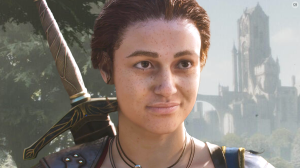
For more than 35 years, Frank Miller has been one of the most innovative, and at times, controversial comic book creators in industry history. As both a writer and artist, Miller has redefined classic characters such as Batman, rescued other heroes from the abyss of cancellation like Daredevil, and created entirely new universes in some of his independent works.
Videos by ComicBook.com
One of those new worlds has been thrust back into the spotlight this week with the release of Sin City: A Dame to Kill For, a sequel to 2005’s Sin City. Based on the independent series Miller scripted and illustrated for Dark Horse Comics in the late 90s/early 2000s, Sin City is notorious for its black and white neo-noir sensibilities, and its hyper-violent and corrupt cast of characters. It is also one of Miller’s most celebrated works, garnering a number of awards.
So let’s take a stroll down memory lane and celebrate the 10 best Miller storylines. Please note that this list is specifically highlighting stories that Miller scripted, though he did provide pencils for a number of them. However, comics where Miller only provided artwork (such as the 1982 Wolverine miniseries) were not included.
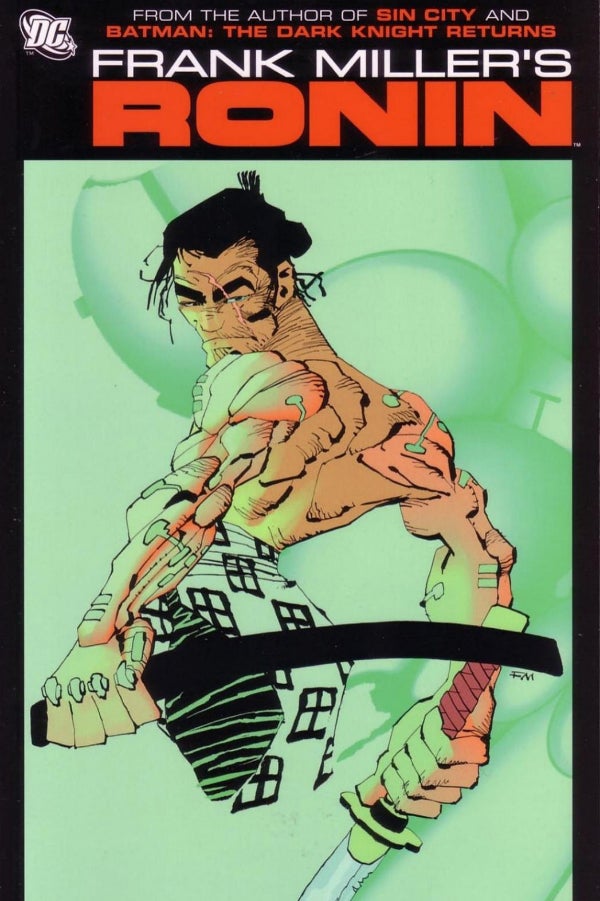
10. Ronin
As equally ambitious as it is weird, this six part limited series, which was published by DC in 1983-84, starts off as a throwback samurai tale before it evolves into a dystopian, cyberpunk story that looks at the power of technology. Miller, who wrote and illustrated the series, reportedly was inspired to create Ronin after researching Kung Fu movies and samurai comic books for his late 70s/early 80s run on Daredevil. Miller has said that he was gripped by the idea of a masterless samurai – called a ronin – and decided to build an entire series around it.
Miller’s narrative is a bit unrefined and at points, hard to follow, while his artwork is clearly missing the boost that Klaus Janson’s inks provided on Daredevil, and later, on The Dark Knight Returns. And yet Ronin remains a grippingly provocative story, and a key part of Miller’s evolution as a creator all the same.
In April, SyFy announced that it was adapting the comic into a television series, though no premiere date or casting announcements have been made.
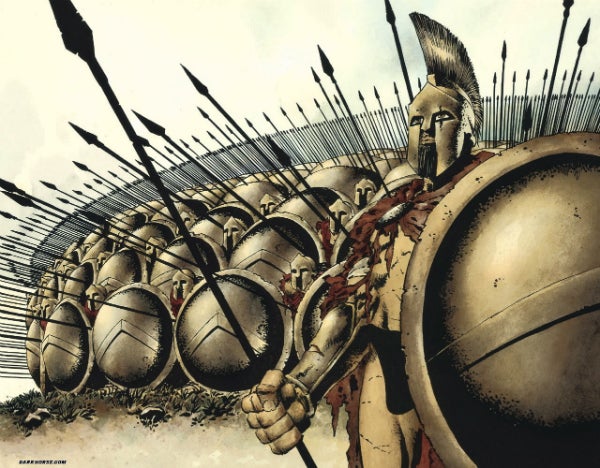
9. 300
Putting aside some of the legit criticisms about its historic inaccuracy (Alan Moore especially had a lot to say about this comic), 300, which was published by Dark Horse as a limited series in 1998, is a big and bold adaptation of the real-life Battle of Thermopylae. The way the comic is visually composed (Lynn Varley’s watercolors win the “Most Valuable Player” award in terms of how they make this bloody story pop), all but scream that 300 should be adapted into a big budget Hollywood movie – something that came to be in 2007.
Sure, it’s ultimately a celebration of preening arrogance and machismo – should the Athenians be any less celebrated (or vilified) than the Spartans for their historic role in the Battle of Thermopylae? But what it lacks in character development, it makes up for its tone, aesthetic, and its ability to transport the reader. 300 is a visually stunning story that puts the reader right in the trenches, shoulder to shoulder with Leonidas and his army.
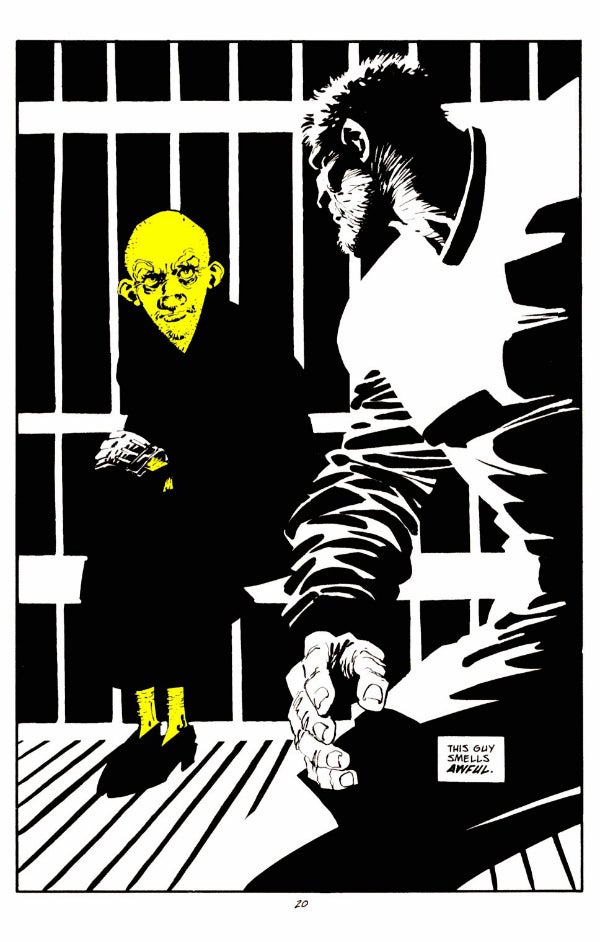
8. Sin City: That Yellow Bastard
Considered by many critics and fans to be the greatest Sin City story, “That Yellow Bastard” puts its focus squarely on one of the few legitimate “heroes” that exist within Miller’s noir-inspired universe, policeman John Hartigan. The story was also adapted for the original Sin City film in 2005 (with Bruce Willis as Hartigan).
By centering the story around Hartigan, Miller manages to tell one of his more uncomplicated Sin City stories. For a change of pace, the reader is not faced with having to root for a character that is unjustifiably violent, sociopathic or some other kind of social deviant. Of course, in typical Sin City fashion, the storyline doesn’t have a happy ending for the hero, but that doesn’t change the fact that Cartigan is the most easy-to-like character in the series.
The comic is also notable for how it visually differentiated itself from previous Sin City stories. “That Yellow Bastard” is still primarily a black and white comic, but Miller adds yellow embellishments to the Roark Junior character – an artistic decision that is so striking, it successfully creates an even greater aura of terror around the character whenever those yellow brushstrokes appear on the page.
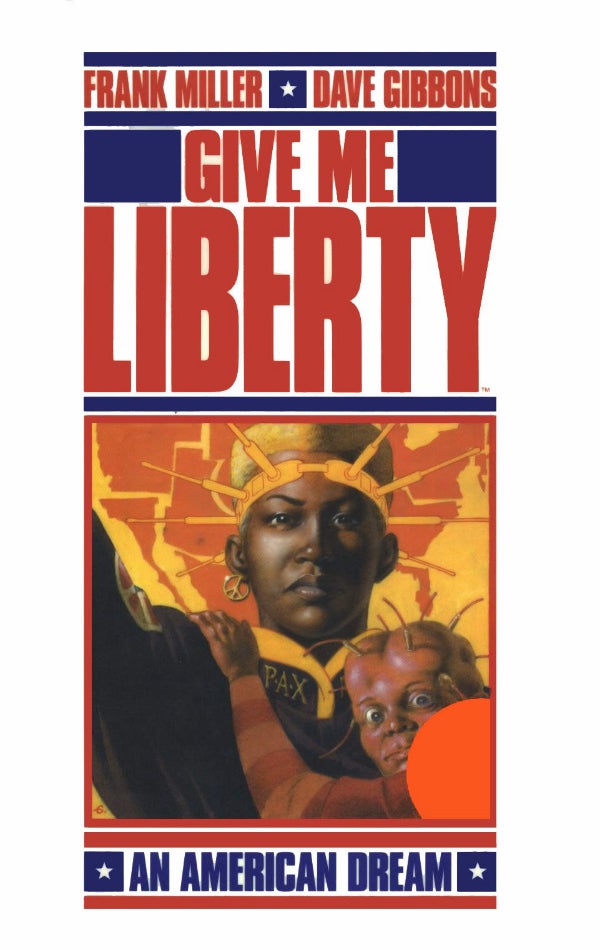
7. Give Me Liberty: An American Dream
Unlike many other Miller stories, Give Me Liberty, which was published by Dark Horse in 1990 and featured artwork from Dave Gibbons, stars a female protagonist, a young American girl named Martha Washington. However, this is still a Miller story so some of the usual rules apply – it’s set in a dystopian future where political corruption and extremism reigns supreme.
Still, what Give Me Liberty lacks in thematic nuance and subtlety, it makes up for in its candid and unapologetic stance on the decline of American civilization – in how corporate greed and corruption has rotted the United States to its core, polarizing Americans into different factions and ultimately inspiring a second civil war.
The four-part miniseries inspired a number of other Martha Washington stories, which can now be found in the huge Life and Times of Martha Washington collection.

6. Daredevil: The Man Without Fear
In the character’s 50 year history, a number of incredible creators have worked on Daredevil. But if everyone is being completely honest with themselves, Miller was and remains the best suited to reimagine Matt Murdock/Daredevil’s origins in a way that pays honor and homage to his critically and commercially successful run in the late 1970s/early 80s.
For this 1993 miniseries, Miller collaborates with John Romita Jr. and Al Williamson to craft this fantastic new origin story for Daredevil. The basic tenets of what Stan Lee and Bill Everett first put forward in 1964 remain intact – Murdock, as a young man, is rendered blind but with enhanced senses after an accident. He then takes on the mantle of the crime fighting vigilante Daredevil after his father, a boxer, is murdered by the mob. However, Miller builds on Matt’s first origin story and transforms it into an epic. He integrates characters that were first introduced in Daredevil in the 70s and 80s, such as Stick and Elektra, and establishes how and why they were important to Daredevil’s evolution as a hero. Miller demonstrates a link between Daredevil and the Kingpin of crime, Wilson Fisk, from the very beginning, again reinforcing how such a complex and dramatically wonderful relationship would be eventually forged.
There’s often a lot of carping from fans when creators introduce such dramatic changes to a beloved character’s earliest days as a hero, but Miller has a certain knack for it (more on that in a moment). As a result, The Man Without Fear is as good as almost any Daredevil story Miller has written.

5. Sin City: The Hard Goodbye
While one can pick nits about whether or not “That Yellow Bastard” was the better Sin City storyline, “The Hard Goodbye” gets the nod here as the story that started it all for Miller’s Sin City universe.
“The Hard Goodbye” introduces the world to Marv, the likeable, if not mentally deranged, individual who is just trying to clear his name after getting framed for murdering a beautiful prostitute named Goldie. While Miller is notorious for his implementation of dark and twisted settings, Sin City takes it to a whole other level. Not only is Sin City rife with political corruption, but it is occupied by an endless parade of thugs, cheats, winos, prostitutes and sociopaths. Marv’s path for vengeance eventually leads to a showdown to the mute cannibal Kevin, and as is often the case in Sin City stories, things never end well for the main character.
But what’s most striking about “The Hard Goodbye” is Miller’s noir-inspired visual style. The black and white palette and heavy use of shadows and silhouettes gives Sin City an authentic 1930s vibe, which stands in stark contrast to some of the futuristic settings used by Miller in comics like Ronin and Dark Knight Returns. Plus, the noir imagery worked perfectly for 2005’s film adaptation (which also used “The Hard Goodbye,” with Mickey Rourke as Marv).
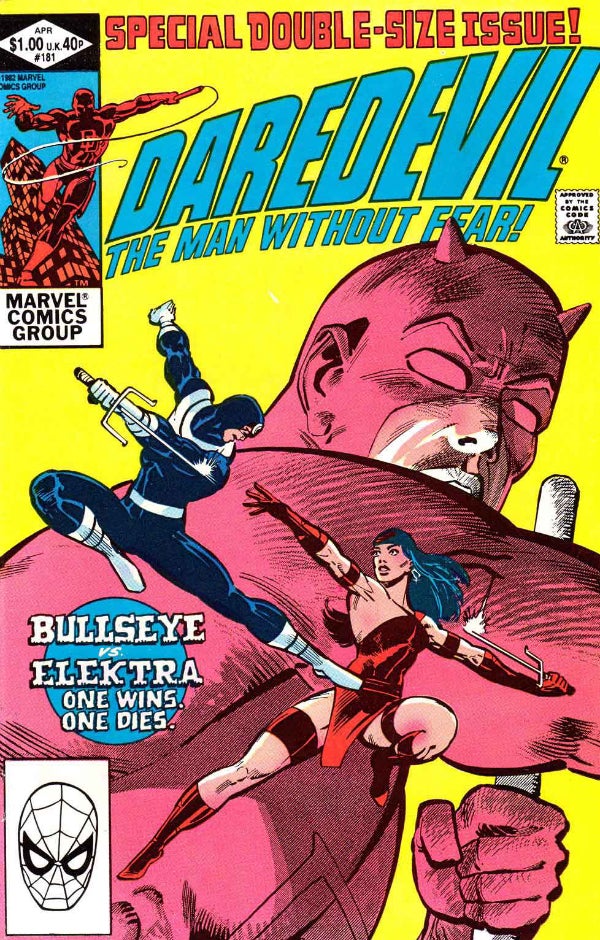
4. “The Elektra Saga” (Daredevil #168, 174-182)
Unquestionably the one storyline people think of when talking about Miller’s original run on Daredevil in the late 1970s/early 80s, this string of issues, dubbed “The Elektra Saga,” demonstrate Miller’s ability to create a new character, develop her, and then rip our collective hearts out by killing her off.
That character, of course, is the ninja assassin Elektra Natchios, who first appears in Daredevil #168 when she is introduced as a former lover of Matt Murdock’s from college. Her return to New York City immediately causing conflict for Matt, as he clearly still harbors feelings for her despite the fact that she’s working as a hired mercenary. Miller, and inker/artist Klaus Janson then ratchet up the drama a few more notches when Elektra aligns herself with the Kingpin.
In addition to Elektra’s development, “The Elektra Saga,” also goes a long way in establishing just how mentally unhinged the villain Bullseye is (a character flaw that would go on to haunt Matt many times over), and it sets up Daily Bugle reporter Ben Urich as one of the better non-superpowered supporting cast members in the Marvel Universe.
And no one can forget Elektra’s death at the hands of Bullseye in Daredevil #181, in one of the most visually iconic and shocking scenes in Marvel history. The fact that such a popular character who had just been introduced was killed off so quickly stunned readers. And Elektra managed to stay dead for a while too, until she was eventually resurrected in the early 90s.
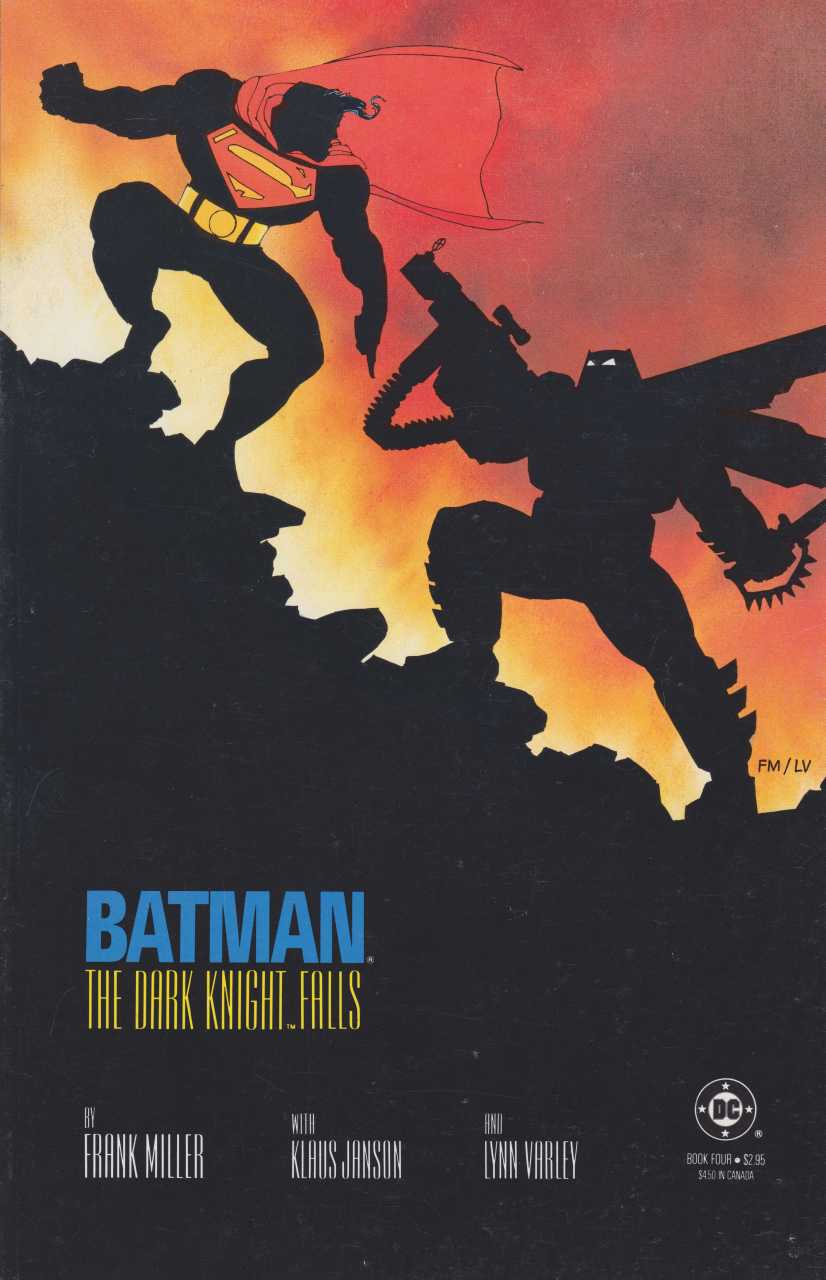
3. The Dark Knight Returns
Arguably the story that transformed Miller into an industry icon, this 1986 miniseries has had a profound effect on the Batman mythos, and the comic book industry as a whole, serving as a source of inspiration for a number of writers, artists, screenwriters and film directors. The idea to set an aging superhero in a dystopian future, was wholly unique for its time, and has opened the doors to a parade of imitators within the industry.
Like a number of other Miller works on this list, The Dark Knight Returns is big, bold and bombastic. This is best on display in the story’s final battle between Batman and Superman, when, with time to plan, the “Dark Knight” proves that he can best the nearly invincible “Man of Steel” with guile and intelligence. The Dark Knight Returns also incorporates other themes that have become standard operating procedure for how almost every other Batman story has been constructed over the past 30 years – themes such as how much Gotham “needs” Batman, and how Batman himself tends to draw out Gotham’s lunatics like moths to a flame.
The story is not without its flaws, and contrary to popular belief, it had some serious critics when it was first published (one writer for the New York Times called it “convoluted” and mocked how colorist Lynn Varley was credited for providing “Colors and Visual Effects”). But these little blemishes have almost added to the book’s charms over the years. The Dark Knight Returns is unapologetic about the fact that some people will inevitably find it to be overrated. It’s too busy being one of the most epic superhero stories ever told.
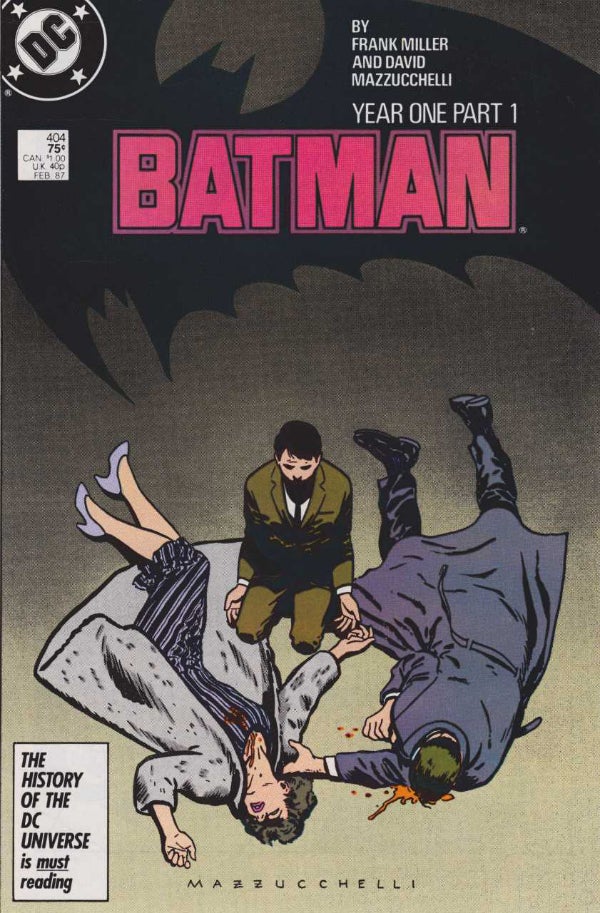
2. “Batman: Year One” (Batman #404-407)
It’s honestly a coin flip when it comes to picking a favorite Miller-Batman story. “Year One” gets the edge over Dark Knight Returns because it’s had an arguably more significant impact on how mainstream/casual fans view Batman when compared to the Dark Knight Returns.
But again, it all comes down to a matter of preference.
Even after the very successful “Zero Year” storyline by Scott Snyder and Greg Rucka, which is the “New 52” era’s take on Batman’s earlier days, “Year One” will, in all likelihood, be viewed as the definitive take on Batman’s origins until the character ceases to exist. The story has been adapted so many times, across all media, that it’s become pervasive. Pretty much everything that is generally accepted about Batman – his origin story, his inextricable link to police officer James Gordon, the gritty darkness of the Batman universe – is a key part to how Frank Miller, and artist David Mazzucchelli, craft their story.
But beyond its influence on the Batman mythos, “Year One” is also just a fantastic story that is dramatically gripping, while also being steeped in a level of realism that isn’t typically found in a mainstream superhero comic.

1. “Born Again” (Daredevil #227-231)
And millions of Batman fans just rolled their eyes in unison. Really? “Born Again?” The GREATEST Frank Miller story?
Yes, “Born Again.” The Dark Knight Returns and “Batman: Year One” have undoubtedly had a larger impact on the comic book industry, and Batman is, without argument, a far more popular superhero property than Daredevil. But in terms of its structure, emotional journey and resolution, “Born Again” is one of the greatest superhero stories to ever be written.
Not a single panel or narrative sequence feels wasted in this story. The opening chapters of “Born Again” feel as despairing as it gets in comics, only for Miller and David Mazzucchelli to slowly (but not too slowly) rebuild Matt Murdock’s faith in himself, and the reader’s emotional connection to Murdock. Daredevil’s emergence from the flames in the final panel of Daredevil #232 may be one of the most emotionally electrifying images in Marvel Comics history. And then Miller and Mazzucchelli go and stick the landing in a very satisfying final chapter that shows the hero as being triumphant, the villain getting his comeuppance (but still left powerful enough to strike again in the future) and the redemption of a long-time fan favorite supporting cast member.
We all read superhero comic books for different reasons, but a majority of fans ultimately want to experience the joy of seeing good triumph over evil in a way that doesn’t’ betray any of the characters. “Born Again” delivers on that joy, probably more than any other superhero comic out there. For fans that are tired of anti-heroes, and shades of grey, and evil ruling the land, reading (or rereading!) “Born Again” should hopefully remind them that there are instances where the genre gets it just right.







